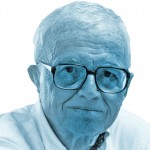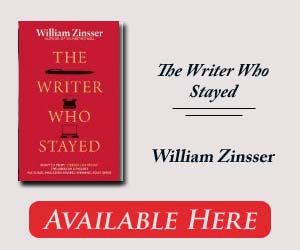
Writing is learned by imitation; we all need models. “I’d like to write like that,” we think at various moments in our journey, mentioning an author whose style we want to emulate. But our best models may be men and women writing in fields different from our own. When I wrote On Writing Well, in 1974, I took as my model a book that had nothing to do with writing or the English language.
My earliest models were the sportswriters of the New York Herald Tribune, The New York Times, and the baseball-obsessed New York Sun, an afternoon paper that I would yank out of my father’s arm when he came home from work. I couldn’t wait to read the latest insights of Will Wedge, who wrote three pieces every day under different bylines (my favorite was “By the Old Scout”), and of W. C. Heinz, who later achieved wide esteem as a magazine journalist and novelist. The sportswriters were my Faulkner and my Hemingway. They reared me on a style that was plain and direct but also warm. That style would last me well into my teens, when I discovered E. B. White.
White took the plain style and gave it urbanity. In his New Yorker essays he was a little more assured than the rest of us. He had a poet’s ear for rhythm and cadence and he had perfect pitch; he knew when it was O.K. to drop a slang term or a colloquial phrase into an elegant sentence without defiling its elegance. I saw him as a wise elder, talking to me with common sense and humor, and I thought: “I could be a young wise elder!” I adopted that seemingly casual but hard-wrought style, and it carried me through two decades of writing for the style-proud New York Herald Tribune and for the best magazines of the day. I assumed I would write that way forever.
In 1970 I moved to Yale to teach nonfiction writing. During that period I did almost no writing myself, but I did a lot of thinking about how to help other people write warmly and well, and that process had nothing to do with handing down grand truths from an essayist’s perch. It had to do with leading by the hand, building confidence, finding the real person inside the bundle of anxiety.
In the summer of 1974, when I was complaining to my wife that I was out of ideas, she said, “You ought to write a book about how to write.” Her suggestion took me by surprise, but it felt right; I liked the thought of trying to capture my course in a book. But what kind of book? The dominant manual at that time was The Elements of Style, by E. B. White and William Strunk Jr., which was White’s updating of the book that had most influenced him, written in 1919 by Strunk, his English professor at Cornell. My problem was that White was the writer who had most influenced me. How could I compete?
But when I analyzed White’s book its terrors evaporated. I realized that it was essentially a book of pointers and admonitions: do this, don’t do that. What it didn’t teach was how to apply those principles to the various forms that nonfiction writing can take. That was what I taught in my class and it’s what I would teach in my book. I wouldn’t compete with The Elements of Style; I would complement it.
That decision gave me my pedagogical structure. It also freed me from my Svengali. I saw that I was long overdue to stop trying to write like E. B. White—and trying to be E. B. White, the sage essayist. Although I never met him, he and I were obviously not at all alike. White was a passive observer of events, withdrawn from the tumult, his world bounded by his office at The New Yorker, his apartment in mid-Manhattan, and his farm in Maine. I was a participant, a seeker of people and far places, of change and risk. Now I was also a teacher, stretched by every new student who came along. The personal voice of that teacher, not the voice of a classroom instructor, was the one I wanted narrating my book.
Such a book would require a different kind of model, written by someone whose company and turn of mind I enjoyed, whatever he or she was writing about. The book I chose was American Popular Song: The Great Innovators, 1900-1950, by the composer Alec Wilder. Wilder’s book, which had just been published, was one I had been waiting for all my life—the bible that every collector hopes someone will write in the field of his addiction. I was an addict of the songs generically known as the Great American Songbook.
Wilder studied the sheet music of thousands of songs and selected 300 in which he felt that the composer—Jerome Kern, Harold Arlen, George Gershwin, Irving Berlin—had pushed the form into new terrain. In the book he provides the pertinent bars of music to illustrate his point or to single out a phrase that he finds original or somehow touching. But, beyond Wilder’s erudition, what I loved most was his commitment to his enthusiasms, as if to say, “These are just one man’s opinions—take ’em or leave ’em.”
 Thus I saw that I might write a book about writing that was just one man’s opinions—take ’em or leave ’em. Like Wilder, I would illustrate my points with passages by my favorite nonfiction writers. Above all, I would treat the English language spaciously, not as a narrow universe of rules and regulations, talking to my readers directly (“you’ll find,” “don’t forget”) and taking them along on decisions I made during my own career as a journalist.
Thus I saw that I might write a book about writing that was just one man’s opinions—take ’em or leave ’em. Like Wilder, I would illustrate my points with passages by my favorite nonfiction writers. Above all, I would treat the English language spaciously, not as a narrow universe of rules and regulations, talking to my readers directly (“you’ll find,” “don’t forget”) and taking them along on decisions I made during my own career as a journalist.
So it came about that I found my true style when I was in my mid-50s. Until then it more probably reflected the person I wanted to be perceived as—the youthful and witty columnist and critic. But that person was never really me. Not until I became a teacher and had no agenda except to be helpful did my style become integrated with my personality and my character.


